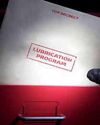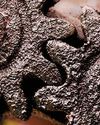
The particles of greatest importance are wear metals, although other particles, such as fibers and foreign materials, are also identified.
Still widely referenced today, Wear Particle Atlas serves as a foundational reference for the various wear particle techniques currently being developed. This includes both microscopic and digital approaches.
Microscopic particle evaluation requires that particles are deposited onto a static surface and inspected with a microscope. Digital particle identification techniques measure pixels associated with the particles, which are dynamically measured as they flow past a detector array. The American Society for Testing and Materials (ASTM) is actively involved in developing standards to improve the value and utility of both approaches.
Microscopic Evaluation of Wear Particles
Using a microscope to inspect particles extracted from oil samples is a powerful and universally used advanced oil condition monitoring technique. As ASTM standardized this, it found that the classification and identification of particles were not uniformly applied by the end-user community.
As a result, ASTM D7684 was written to standardize the terminology and description of particle shapes, textures, and colors. ASTM D7670 (membrane filters) and D7690 (Ferrography) were written to support test methods that can be used to separate and deposit the particles from the oil onto patch or glass substrates for visual analysis.
While this technique is widely used, there are several problems with this long-standing and trusted method. Microscopic evaluation of particles requires a trained and experienced eye. Knowledge of both particle morphology and machine metallurgy is a requirement for properly executing microscopic particle evaluation.
Esta historia es de la edición March - April 2024 de MACHINERY LUBRICATION INDIA.
Comience su prueba gratuita de Magzter GOLD de 7 días para acceder a miles de historias premium seleccionadas y a más de 9,000 revistas y periódicos.
Ya eres suscriptor ? Conectar
Esta historia es de la edición March - April 2024 de MACHINERY LUBRICATION INDIA.
Comience su prueba gratuita de Magzter GOLD de 7 días para acceder a miles de historias premium seleccionadas y a más de 9,000 revistas y periódicos.
Ya eres suscriptor? Conectar

The Secrets For Implementing A Clean lubricant Program
If you could find an investment that guaranteed a return 40 times greater than your initial investment, you probably wouldn't pass it up.

MAINTAIN? REPAIR? REPLACE?
When considering the life of any asset, the question arises: what types of interventions should be planned to keep it operating or to restore operation in the event of its failure?

Engineering Reports Should Be Like Bad Movies
I'm frequently asked to review engineering reports, and I'm continually baffled by how many engineers want to take their readers on a journey instead of getting to the point.

WHY SCHEDULED OIL CHANGES AREN'T ENOUGH TO MITIGATE LUBRICANT CONTAMINATION
There are few problems more insidious or damaging to large industrial machinery than contaminated lubricant.

LUBRICATION CONTAMINATION PREVENTION
How many articles have you read, or seminars listened to, that tout the value of contamination control? If you are like me, they number in the hundreds—if not thousands. One thing about these articles and seminars that bothers me is the word “control”.

LUBRICANT CONTAMINATION PREVENTION AND MITIGATION: A Guide For Maintenance Professionals
Lubricants are essential for the smooth and efficient operation of many types of machinery, from engines and turbines to gears and bearings.

TASK-BASED TRAINING | INSPECTING A SINGLE-POINT LUBRICATOR
A single-point lubricator is a device engineered to attach to a single unit to regularly and automatically deliver a small amount of clean grease or lubricating oil to a specific area.

TOP LEADERSHIP FOCUSES FOR IMPROVED RELIABILITY AND COST REDUCTION
Here’s a scenario that may sound eerily familiar – you have a new reliability initiative.

4 KEY ELEMENTS FOR INTERPRETING AN OIL ANALYSIS REPORT
Years ago, a customer came into my office, visibly upset. He had just received his second oil analysis report for one of his Caterpillar gas engines.

ASTM ENHANCEMENTS TO MICROSCOPIC PARTICLE IDENTIFICATION AND DOCUMENTATION
In 1982, Daniel Anderson published his influential book, \"Wear Particle Atlas\", which describes, sizes, and classifies particles found in oil.